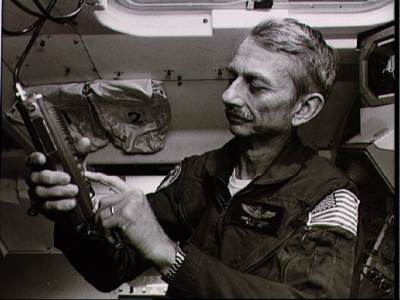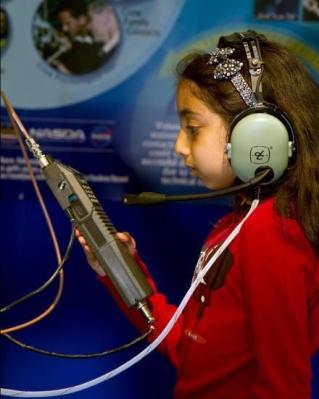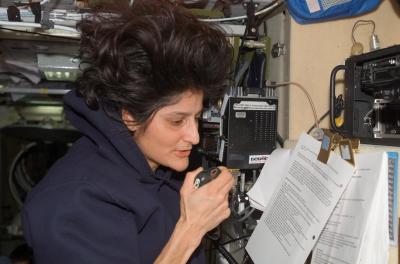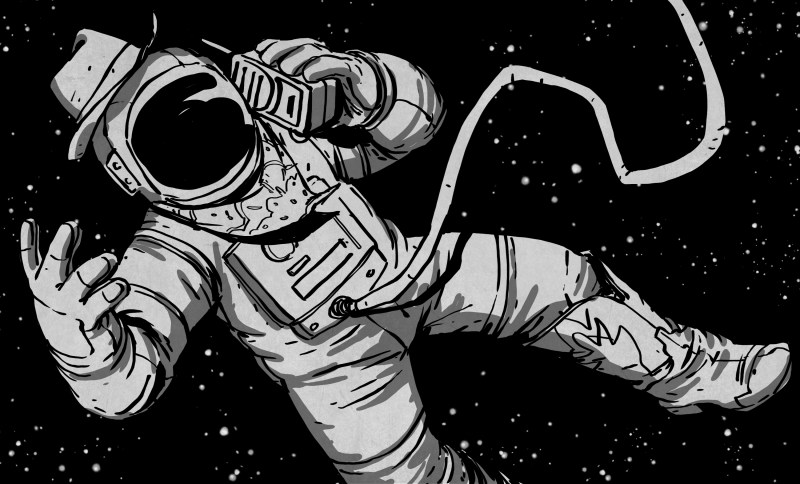Whether it’s trying to make contacts across the planet with a transmitter that would have a hard time lighting an LED, or blasting signals into space and bouncing them off the moon, amateur radio operators have always been on the forefront of communications technology. As mankind took to space in the 1950s and 1960s, hams went along for the ride with the first private satellites. But as successful as the OSCAR satellites were, they were still at best only beacons or repeaters in space. What was needed was the human touch – a real live operator making contacts with people on the ground, showing the capabilities of amateur radio while generating public interest in the space program. What was needed was a ham in space.
If at First You Don’t Succeed…
The first attempt to get an amateur radio station into space with a licensed operator started in the waning days of the Apollo era. Owen Garriott (W5LFL) had a Ph.D. in electrical engineering at the time he was selected as one of the first six scientist-astronauts in 1965. He trained for and eventually flew on Skylab 3 in 1973. Late in the run-up to his mission, Garriott made a formal proposal to take along a ham rig so he could make contacts from orbit. NASA liked the idea, but because the idea came up so late in the mission cycle, there was no time to get the gear properly certified for spaceflight and the proposal was rejected.

Fortunately, Garriott would have another mission and another chance to become the first ham in space. Garriott was selected as a mission specialist for STS-9, the Spacelab-1 mission that flew on shuttle Columbia in 1983. Properly prepared this time, Garriott went aloft with a Motorola MX-300 handheld transceiver for the 2-meter band. The antenna was a bit of a compromise; no provision had been made on the Shuttle for an external antenna, so a cavity antenna was mounted to one of the windows with Velcro. The lucky ham to log the first contact (QSO) with an astronaut in orbit was Lance Collister (WA1JXN) of Montana.
The 300 or so QSOs Garriott logged during STS-9 – including VIPs such as US Senator Barry Goldwater (K7UGA) and King Hussein of Jordan (JY1) – were a public relations coup for NASA. Talking directly to someone in orbit had once been a privilege reserved for other astronauts and presidents. Now, any ham could make contact with an astronaut, and what’s more, any ham could use his or her gear and expertise to let school children talk to astronauts.
Inspiring the Next Generation
Recognizing a good thing when they saw it, NASA formalized ham radio in space with SAREX, the Space Amateur Radio Experiment. In cooperation with the Radio Amateur Satellite Corporation (AMSAT) and the American Radio Relay League (ARRL), and with the express intention of getting young people excited about careers in science and engineering, SAREX flew on 25 Shuttle missions from 1983 to 1999.
As the SAREX program progressed, the amateur radio gear flown with missions got more and more complex – slow-scan television (SSTV), an automated packet radio system to enable around the clock QSOs even when the station could not be manned, and expansion from the original 2-meter band to the 70-centimeter UHF band. On the ground, build-out of a telebridge system increased the number of schools that could make contact with the Shuttle by providing a telephone link to fixed ground stations.

Short-duration Shuttle missions weren’t the only flights with hams aboard. In 1988, the Russian Mir space station crew, Vladimir Titov, Musa Manarov, and Valery Polyakov earned their amateur licenses while in orbit. Pulling the enviable callsigns U1MIR, U2MIR, and U3MIR, they were later supplied with a Yaesu FT290 2-meter transceiver and an antenna, which was mounted to a handrail during a spacewalk. Hams aboard Mir continued the outreach to schools over the years as equipment was upgraded and crews changed.
By the time the first components of the ISS started going into orbit in 1998, a ham radio presence was already planned. ARISS, the Amateur Radio on the International Space Station program, brought together amateur radio groups from around the world to work on a comprehensive plan for ham radio stations on the ISS. An Ericsson handheld 2-meter rig was among the first payloads sent up to the Russian Zarya module in 1998, underscoring how integral ham radio had become to the spacefaring nations and their efforts to reach out to the public.
Radios for the ISS

On Earth, getting on the air as a ham is pretty easy – study a bit, pass the test, and buy your first rig. Gear selection amounts to what you can afford and what bands and modes you want to use. But when your rig is headed 400 km upstairs to a pressurized tinfoil tube, the gear selection process has to be a bit more stringent. You might think this means the gear is completely custom-built by some government contractor, but as it turns out, pretty much all of the radios flying on the ISS right now are off-the-shelf gear that any ham can buy and operate. Like any other equipment headed to the ISS, ham radio gear has to be flight qualified to make sure it doesn’t pose any hazard to the station or crew, but other than that all the rigs up there today would be familiar to any ham.
There are currently three stations flying aboard the ISS in three different modules. Along with the original Ericsson 2-meter handheld transceiver and packet modem in the Zarya module, there are Kenwood dual-band (VHF and UHF) radios in the Zvezda service module near the dining table, and another station in the Columbus module.
The Ericsson MP-A VHF rig in Columbus has a reputation for ruggedness and reliability, but after 16 years of operation aboard the ISS the radio recently started showing error codes and is currently off the air. ARISS operations were transferred to the station in the Russian modules until a replacement station can be sent up. ARISS already had plans to fly a Kenwood D710-GA and power supply, both of which are undergoing final approval and certification by NASA before going topside.
Antennas

Any ham will tell you that half of the art of amateur radio lies in antenna design and construction. Earthbound hams have a lot of freedom to experiment with antennas and run feedlines through open windows, but things are a bit more constrained for their ISS counterparts.
While the antennas on the early Shuttle missions were somewhat ad hoc, the ISS was designed from the get-go to support multiple external antennas for ARISS operations. Early ISS crews installed four antenna systems around the service module. Designated WA1 to WA4, each antenna consists of Kapton-coated whips for either UHF/VHF or HF signals along with a spiral antenna for the L-band (1-2GHz) and S-band (2-4 GHz). There are no amateur stations aboard the ISS for those bands yet, so the antennas support the Russian Glisser space helmet camera system. Having four antennas around the space station provides redundancy in case of failure and helps keep at least one antenna correctly oriented despite ISS attitude adjustments.
The ham radio presence is space came full circle in 2008 when Owen Garriott’s son Richard Garriott (W5KWQ) traveled as a paying passenger to the ISS with a Kenwood VC-H1 portable SSTV terminal and made hundreds of QSOs. Hams have been operating in space for over 30 years now, and there’s been a continuous ham station operating from orbit for better than a decade and a half. Amateur radio has provided inspiration and education to thousands of kids around the world and has been a source of crew comfort and well-being by providing communication with family and friends. As long as there are manned spacecraft, it’s a good guess that hams will be operating from them.
















They probably get the most enjoyment out of talking with hams outside the states.
Speaking with angry old white men probably gets old pretty fast.
I have a ham license and have never been on air because of years of just listening in to the old, hateful, racist, partisan jibber jabber and elitist equipment pissing matches that go on.
The weather nets were a bit comical and worth listening to though, not because any useful storm information was being passed along, but quite the opposite. Every scud cloud was FOR SURE a rotating funnel cloud with grown men squeeling like little girls about how this is it, town will be destroyed in a matter of seconds and the net leader trying to take control of the situation and sounding like a complete idiot in the process. And the NWS guy calling in once in a while to get an update and you could here the eye roll in his voice when he’s being told of baseball sized hail, which always turns out to be more like pea sized hail.
Sorry if I seem a little skeptical that these people will be our saviors should a natural disaster strike….
All old men get angry easily … they are not young any more, and besides the new generations know nothing about vacuum tubes and analog electronics. Now GTHO my lawn :)
More on topic, what is the lowest usable frequency for Earth to space comms? Sputnik 1 used 20 and 40 MHz, but it appears to me that those will not work at all angles? Also minimal TX powers. Thanks.
That’s a good question about frequency. I think early satellites used low frequencies because receiving equipment at those frequencies were more common. Even in 1972 OSCAR 6 had a 144MHz uplink and a 28MHz downlink. But lower frequencies require larger antennas, harder to fit and deploy on the satellite.
But lower frequencies are more likely to get higher travel, due to propagation. You don’t want or need someone out of sight of the satellite to receive it. And a satellite uses up the frequency, for years. The higher you go the more space there frequency wise, and since it’s line if sight, doesn’t bother anyone who isn’t interested. A beacon takes little frequency space, but translators especially for tv, need lots of bandwidth.
So I suspect the move to higher frequencies was for other reasons.
Michael
Higher freqs mean smaller easier to carry antennas, though they do need more care in design and tolerances. AO-40 had some really cool uhf/microwave bands 1.2mhz and 2.4mhz if I remember right, though it also did 2m and 440. There was an onboard explosion when trying to boost the orbit and it compromised the battery, too bad it is now dead.
1.2 or 2.4 Milli-Hertz are magnitudes away from the microwave range. Even 1.2 or 2.4MHz are not microwaves. I am really no spelling fetishist. But “m” and “M” in SI-prefixes are about 10^9 apart. And in this case probably GHz are meant.
Thanks. “You don’t want or need someone out of sight of the satellite to receive it.” – that is something to ponder, indeed.
Hear you on the angry old foggeys (technically I’m one myself, but try to resist the trend). As far as Ham Radio in space evolution probably the older up and down-link frequencies were more due to the state of the art of receiver front ends and gain management (good S+SN and noise floors vs. putting up bigger antennas to make up for path losses) and how common any given RF art form was on any given band for the given era. We have made a lot of progress to the radio state of the arts in the last 50 years and despite when the old guys say loving their firebottles that are the only “real” way, that’s opened up a lot of new ground (the Hams in Space story here on Hackaday is a good example when it said ISS has external antenna provisions for several bands above 70 cm for future use). And with multitudes of kid (not lids) getting their formative hands on Rasp Pi’s and RF Shields and growing up reading schematics the trend will only accelerate. After coming back home to Ham radio after 30 years (KE0EBP with a General’s ticket) I’m more than stoked at all the possibilities out there now myself. And if the (other) old dogs want to chew their rags on 20m SSB and make that band into a Ham assisted living center then let them.
“Speaking with angry old white men probably gets old pretty fast.”
Troll.
I guess it’s socially acceptable to shit all over old white guys because theu are too busy with their hobbies instead of running around as SJWs? Does your comment also apply to European males?
Please don’t feed the trolls (or become one yourself)
http://i2.kym-cdn.com/photos/images/newsfeed/000/583/041/d5c.jpg
I hope you realize that demeaning “Old White Men” is both racist and sexist (technically also ageist), which is ironic considering you previous statements…
I thought this was hackaday, not tumblr
I’ll take the bait.
Get into SSTV. Get into data modes. Get into DXing. Get into Hellscrieber, get into WSPR.
Or, as Riley Hollingsworth put it,
> “Don’t engage people, and don’t humor the idiots,” he said. “Stupidity can’t be regulated, no matter how good the rules are. Just turn the big knob. Every rig has one.”
Turn the big knob in front of you, not the one on the air.
No you’re very right. I got into it at 16 and finally got licensed a little later. Went for about a year and than hung it up and put my radios in the closet and went to go do something else. Same reason as you, miserable buttheads and useless whackers circlejerking to the thought of another katrina happening so they can be a hero even though they’re completely useless the way they behave.
I was just a young guy who loved shortwave radios and playing with uhf HTs and they made me so deludes and jaded sucking me into the drama. Thankfully I woke up and now I can enjoy the shortwaves and playing with old comercial radios and my scanner and experimenting again. I learned more about radio running a pirate FM station than I ever did when I made the mistake of becoming an amateur operator.
Your comments have NO place in ham radio and you are an absolute discredit to our hobby. “Angry old white men” – If anyone is the racist, it is you.
The coolest thing this year: A Cosmonaut Hat. Literally.
Epic illustration, love it!
:o)
“Fine Business, Old Spaceman”
Why couldn’t I think of that when I was trying to come up with a title?!
And yes, Joe hit it out of the park with his art again. Thanks Joe!
I feel a slight miss… like he’s all…
“Breaker, Breaker, one four for a copy, this is the Gangster of Luuurve, and my 20 is 300 miles above your head this fine day, over.”
Yor forgot the “Shiny side up and greasy side down” part. Always know where your nadir is, Smokey.
But some people call him Maurice.
Bet you weren’t ready for that.
I agree! It’s great!
I am a huge fan of ARISS having listened to between 10-20 ARISS school contacts as well as many SSTV events, all documented on my YouTube channel, and your article was very accurate and up to date! Thanks!
https://www.youtube.com/c/SpaceComms1
73, John Brier KG4AKV
I think one of the most enviable QSOs that will be collected in the next decade will be the first Lunar contacts.
Does anyone know if there is any amateur presence on any of the Lunar X-Prize entries contracted for launch?
I know it would be possible because hams have been doing EM Bounces since the 60’s.
Makes me wonder how many hams tuned in to the Moon/Earth radio communications NASA did during the Apollo missions. That would have been fun, but it occurred several years before I was old enough to hold a microphone.
Relatively few heard much of the moon missions. It was talked about ahead of time, CQ ran a construction article for a converter for tuning one frequency that was to be used. But the communication system was complex, subcarriers and such, and was mostly microwave. At least one system was described in QST, but they only heard the command module, I think it was, and it may have been later than Apollo 11. It was a mix of homemade and surplus, from people already playing with microwave. There wasn’t much mention after the fact about people having heard any of it. That sort of thing would have been big news, so the lack of it seems a good indicator.
Michael
This is the one ham I am aware of who listened to astronauts on the moon:
http://www.arrl.org/eavesdropping-on-apollo-11
73, John Brier KG4AKV
“I know it would be possible because hams have been doing EM Bounces since the 60’s.”
You may be right. But then.. I haven’t seen many viable moonbounce setups that would likely fit in the ‘spare’ space of a passenger rocket.
That’s true, but there are dedicated communities of hams that are into DSN and finding super weak signals from space missions throughout the solar system. I’m sure they would focus on any moon mission with their super amplified detectors.
Though I suppose that’s Rx only.
Moonbounce has become much more viable over the decades as some have built really big antennas. That means others can get by with smaller antennas and lower power. In the early days it required lot, so there were few. And to get that best reception it was finicky, expensive tubes that required a lot of tuning to get the lowest noise figure, or a parametric amplifier that is bulky circuitry and needs fussy tuning. Now there’s lots of off the shelf equipment to get started that beats the equipment of fifty years ago, and Gaasfets that give much lower noise figure with less fussing.
A couple of times in the mid-sixties they used Arecibo for ham moonbounce, and that allowed for such simple equipment at the other end.
Don’t forget that with moonbounce, the signal travels to and from the moon. The signal is weak when it gets to the moon, and loses more strength coming back. Having a station on the moon means the signal coming from the moon is much much stronger, even if that station is even just a few watts.
Also, with low gravity on the moon, a larger antenna is easier to build, less weight to support the rest of it.
And as Heinlein suggested in “Rocket Ship Galileo”, in a vacuum one might be able to build large transmitting tubes without a lot of effort.
Michael
In the sixties there was “Project Moonray” to try to get something onto the moon. I think it was a repeater rather than a station to be operated there. It was to be fitted into a space on the lunar rover, and the idea was being “sold” to NASA on the basis that it could be backup communication.
It’s not clear if it was dreaming or concrete. The main proponent died, which killed the project. But maybe the shortening of the Apollo program would have meant not enough time.
Michael
I hold an Advanced class license, and really have zero desire to chat with the douche bags on my local repeaters. It’s a collection of long winded, clique’ish guys that like to hear themselves ramble on and on. In today’s ‘technology’ society, I’d rather be chatting on the internet with some hot chick off a singles dating site.
So the choices are – chat with long winded, clique’ish douche bag guys – or – chat with hot single blonde babes off a singles dating site. The majority of us would choose the latter option.
But the majority of those “single blonde babes” on chat are actually douche bag guys :) Many cases of fake profiles were reported.
https://youtu.be/UE6iAjEv9dQ
” L-band (1-2GHz) and S-band (2-4 GHz). There are no amateur stations aboard the ISS for those bands yet”
Not true in fact. On S band there is an Amateur live Video downlink called HAMTV. This has been used often recently by mostly Tim Peake the UK Astronaut. They connect a TV camera and the signal comes down on 2395Mhz. Anyone can see the live signal, but most of the time the camera is no connected but a “blank transmission” is received which is useful for testing. The signal is encoded using MPEG2 and the DVB-S standard.
I have received it may times and I look after one of the “official” volunteer ground stations.
See here:
http://www.amsat-on.be/ham-tv-summary/
Video recordings here:
https://www.youtube.com/channel/UCQS-yDk7PdE9cRv4MNu8pCw
If they get the funds donated they may add more to the system such as the ability to downlink to USA schools in addition to the existing European Union ground stations.
I got half a QSO with MIR once, it was when Shannon Lucid was there in 1996, too bad I didn’t get it confirmed.
There will also be a ham radio payload on the moon in november 2017 if all goes to plan, they are working on the payload right now at the University of Umeå Sweden .
It will be some kind of field meter, transmitting data back to earth on some ham-radio freq if I remember correct.
The project is run by Space science sweden and is called Umeå lunar venture
https://spacesciencesweden.se for more info
I work in a radio shop that supports GE/MA-Comm/Ericcson/Harris radios. I believe we even have one old MP-A still in use. Who do I see about making a service call? :-)
I’ve been a licensed SW operator for years. The nym “amateur” is silly. Never liked it. I’ve never had an occasion to talk with anyone on the air, nor the inclination. I use SW primarily as a test bed for systems that will (post dev) move to commercial bands, and for packet, and for auto patching to my wife (that’s talking to someone on the phone with a SW radio…) – so that I don’ t have to use to use my cell, which will go down (again) in the next 911. We have a base station at home and one in her car that she will use illegally during the next apocalypse, thank you. Old dudes can be pretty nice, and some of them know more than you could ever imagine. If nothing else, never underestimate one. ~ 73s
Never underestimate one….
Yup, I want to be Old Man Henderson when I grow up… https://1d4chan.org/wiki/Old_Man_Henderson